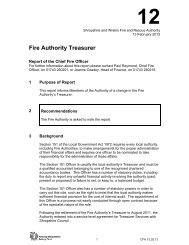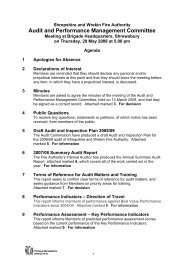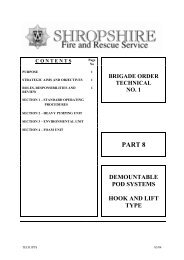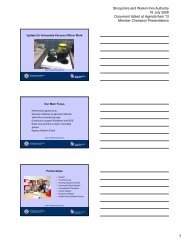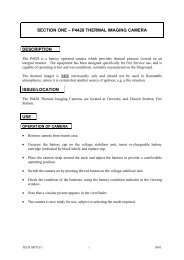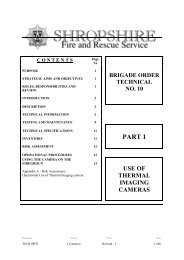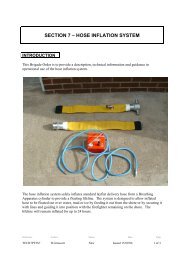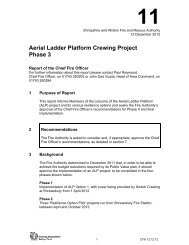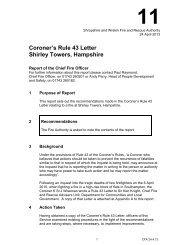Brigade Order - Shropshire Fire and Rescue Service
Brigade Order - Shropshire Fire and Rescue Service
Brigade Order - Shropshire Fire and Rescue Service
You also want an ePaper? Increase the reach of your titles
YUMPU automatically turns print PDFs into web optimized ePapers that Google loves.
<strong>Brigade</strong> <strong>Order</strong> Operations 4<br />
Part 6<br />
Section<br />
Title Larger Volume Pumping Unit Mobilisation<br />
Reference<br />
OPS4PT6<br />
Author<br />
M Timmis<br />
Status<br />
Amended<br />
Date<br />
01/11<br />
<strong>Brigade</strong> <strong>Order</strong><br />
Contents Page No.<br />
Purpose 1<br />
Strategic Aims <strong>and</strong> Objectives 1<br />
Introduction 1<br />
The HVPU 2<br />
The HPU 2<br />
The LPU 2<br />
In County Mobilisation 2<br />
Out of County Mobilisation 4<br />
Welfare 4<br />
Roles, Responsibilities <strong>and</strong> Review<br />
The Head of Operations <strong>and</strong> Risk is responsible for ensuring this <strong>Order</strong> is implemented<br />
across the <strong>Brigade</strong>.<br />
The Head of District Performance will be responsible for the day to day operation of the<br />
<strong>Order</strong>.<br />
The Head of Operations <strong>and</strong> Risk will review this <strong>Order</strong> when new legislation arises or<br />
as <strong>and</strong> when organisational needs require.<br />
Page<br />
1 of 5
<strong>Brigade</strong> <strong>Order</strong> Operations 4<br />
Part 6 – High Volume Pumping Unit Mobilisation<br />
Purpose<br />
The purpose of this <strong>Order</strong> is to detail the mobilisation procedures for all of the Large<br />
Volume Pumping Units.<br />
Strategic Aims <strong>and</strong> Objectives<br />
This <strong>Order</strong> supports the following Strategic Aims:<br />
Aim 1: Reduce the risk to life <strong>and</strong> material loss from fires, road traffic collisions <strong>and</strong> other<br />
emergencies in the community.<br />
Aim 2: Protect life, property <strong>and</strong> the environment from fire <strong>and</strong> other emergencies.<br />
Aim 3: Secure the highest level of safety <strong>and</strong> welfare/wellbeing for all staff <strong>and</strong> Authority<br />
Members.<br />
Aim 4: Provide a sustainable service that demonstrates quality <strong>and</strong> best value in service<br />
provision.<br />
Introduction<br />
The national “New Dimension” project which puts national resilience at the heart of<br />
operational response has led to a number of assets being distributed throughout the<br />
regions. One such asset is the High Volume Pumping unit (HVPU), which is capable of<br />
delivering or moving up to 7000 litres of water per minute at up to 60 metres head for use<br />
where large volumes are required at incidents for fire fighting or in flood conditions.<br />
In <strong>Shropshire</strong> we have two other large volume pumps. These are all available for local <strong>and</strong><br />
national use, but normally when the units are requested outside the county the unit at<br />
Prees will be mobilised first. This order sets out the mobilising protocols for all three larger<br />
volume pumps.<br />
The High Volume Pump (HVPU) is based at Prees <strong>and</strong> will normally be staffed by<br />
personnel from Prees. Being a national asset, the HVP can be mobilised to any significant<br />
event where the equipment <strong>and</strong> crew can assist in bringing large incidents to a satisfactory<br />
conclusion. A further 4 HVPU units are available within the West Midl<strong>and</strong>s region <strong>and</strong> can<br />
be called upon to assist with incidents inside <strong>Shropshire</strong>. There are 50 HVP units in<br />
Engl<strong>and</strong> <strong>and</strong> Wales.<br />
Reference<br />
OPS4PT6<br />
Author<br />
M Timmis<br />
Status<br />
Amended<br />
Date<br />
01/11<br />
Page<br />
1 of 4
The Heavy Pumping Unit (HPU), formerly located at Shrewsbury has now been relocated<br />
to Craven Arms in order to support the water supply strategy adopted by SFRS in 2008. It<br />
is generally crewed by personnel at Craven Arms <strong>and</strong>/or Clun.<br />
The Light Pumping Unit (LPU) remains at Shrewsbury <strong>and</strong> is generally crewed by RDS<br />
staff from Shrewsbury.<br />
All three of these appliances are termed Large Volume Pumping Units (LVPU) for the<br />
purposes of this mobilising <strong>Order</strong>.<br />
The HVPU<br />
A HVPU consists of a Prime Mover (chassis/cab vehicle with hook-lift) <strong>and</strong><br />
2 demountable containers. The first container holds the demountable HVP unit, known as<br />
a Hydrasub, hose retrieval system <strong>and</strong> 1 kilometre of 150 mm hose. The second container<br />
holds a further 2 kilometres 150 mm hose with retrieval system. In <strong>Shropshire</strong> the second<br />
container of hose will normally remain stowed on a separate Prime Mover for speed of<br />
response.<br />
The HPU<br />
Similarly, the HPU consists of a Prime Mover (chassis/cab vehicle with hook-lift) <strong>and</strong><br />
2 demountable containers of hose <strong>and</strong> equipment.<br />
The LPU<br />
The LPU is slightly smaller <strong>and</strong> gives access in restricted areas. However it has similar<br />
pumping capacity to the physically larger units. Level One <strong>and</strong> Two Incident Comm<strong>and</strong>ers<br />
may determine that access would be difficult for the larger units <strong>and</strong> may request the<br />
attendance of the LPU. This must be clearly articulated to <strong>Fire</strong> Control giving an<br />
explanation for not requiring the nearest appliance.<br />
In County Mobilisation<br />
When additional pumping capacity is required within the <strong>Brigade</strong>, the Incident Comm<strong>and</strong>er<br />
should request that the attendance of the nearest Larger Volume Pumping Unit. <strong>Fire</strong><br />
Control will mobilise the nearest suitable pumping unit.<br />
The county is divided into three segments <strong>and</strong> based on station areas the following<br />
mobilisation will apply:<br />
Reference<br />
OPS4PT6<br />
Author<br />
M Timmis<br />
Status<br />
Amended<br />
Date<br />
01/11<br />
Page<br />
2 of 4
North – HVPU (PR) Central – LPU (SY) South – HPU (CA)<br />
Reference<br />
OPS4PT6<br />
WH NP CA<br />
MD AL CL<br />
BS SY BC<br />
WM TC CM<br />
HO TW LU<br />
PR WL MW<br />
EL MY CS<br />
Author<br />
M Timmis<br />
BN<br />
OS<br />
Should the High Volume Pumping Unit be required it will be crewed in the first instance by<br />
personnel from Prees <strong>and</strong> both Prime Movers with containers will be mobilised to the<br />
incident, or other location specified. Normal fireground welfare provisions will apply.<br />
Crews will be mobilised to their home station <strong>and</strong> proceed to Prees in a service<br />
vehicle/appliance. Should all of these crews be committed elsewhere <strong>Fire</strong> Control will<br />
make arrangements for one of them to be relieved so that the HVP can be mobilised.<br />
The LPU will be mobilised using crews from Shrewsbury RDS. If they are unavailable a<br />
crew from Baschurch will be mobilised to Shrewsbury in their appliance <strong>and</strong> will then<br />
mobilise the LPU.<br />
The HPU will be mobilised with a crew from Craven Arms. Should they be unavailable Clun<br />
will proceed in their appliance to Craven Arms to mobilise the HPU.<br />
In the event that there is a shortfall of crew the officer in charge may request support from<br />
one of the support stations identified above.<br />
Each LVPU vehicle should be mobilised with a minimum of two personnel <strong>and</strong> a maximum<br />
of three. These appliances will always be supported by another pumping appliance,<br />
normally from the host station or identified support station.<br />
When an incident requires mobilisation of a LVPU to an incident within its’ own station area<br />
it is likely that the crew will already be in attendance.<br />
Status<br />
Amended<br />
Date<br />
01/11<br />
Page<br />
3 of 4
The mobilising officer will then need to consider whether to mobilise the next nearest<br />
LVPU, or the next nearest appliance to take over from the LVPU crew in order that they<br />
can return to their own station to mobilise the pump.<br />
Out of County Mobilisation<br />
The HVP is a national asset <strong>and</strong> as such can be requested to attend incidents anywhere in<br />
the United Kingdom. Calls for assistance will normally be generated either by the <strong>Fire</strong> <strong>and</strong><br />
<strong>Rescue</strong> <strong>Service</strong> National Coordinating Centre (FRSNCC) or the host <strong>Fire</strong> <strong>and</strong> <strong>Rescue</strong><br />
<strong>Service</strong> Control.<br />
<strong>Fire</strong> Control staff will notify FRSNCC (if they have not generated the call) that the HVP has<br />
been mobilised out of county.<br />
<strong>Fire</strong> Control will notify the Executive Officer <strong>and</strong> Principal Officer.<br />
Both Prime Movers <strong>and</strong> containers will be mobilised directly to a specified rendezvous<br />
point within the hosting <strong>Fire</strong> <strong>and</strong> <strong>Rescue</strong> <strong>Service</strong> (FRS) ground <strong>and</strong> on arrival will be under<br />
the comm<strong>and</strong> of the host FRS Incident Comm<strong>and</strong>er.<br />
Both appliances must ensure that <strong>Shropshire</strong> <strong>Fire</strong> Control is aware of their mobilisation<br />
status verbally by radio or mobile telephone so that records of mobile <strong>and</strong> attendance times<br />
can be recorded. National call signs will be adopted. These are currently:<br />
Welfare<br />
Reference<br />
OPS4PT6<br />
Author<br />
M Timmis<br />
Prime Mover Mike 01<br />
Prime Mover XXX<br />
HVP module Papa 11<br />
Hose<br />
module<br />
Hotel 11<br />
The deployment of the HVP beyond SFRS boundaries may require the vehicle to be away<br />
for several days, dependent on the nature of the incident <strong>and</strong> the distance travelled.<br />
A specialist officer will be alerted to take the role of “Welfare (Supplies) Officer” (see<br />
<strong>Brigade</strong> <strong>Order</strong> Operations 4 Part 5)) <strong>and</strong> will arrange feeding as appropriate. As only small<br />
numbers of personnel are involved this officer will also be able to deal with any other<br />
welfare issues that may arise.<br />
After the initial mobilisation <strong>and</strong> welfare provisions the host FRS will make arrangements to<br />
ensure that crew requirements are adequately catered for <strong>and</strong> relief crews are arranged<br />
within a reasonable timescale. It is unlikely that normal relief frequencies will be<br />
achievable <strong>and</strong> appropriately trained relief crews may be called upon either from<br />
<strong>Shropshire</strong> or another FRS.<br />
Reliefs to incidents within <strong>Shropshire</strong> will be drawn from any of the five stations that have<br />
been trained to operate the three LVPU.<br />
Status<br />
Amended<br />
Date<br />
01/11<br />
Page<br />
4 of 4



